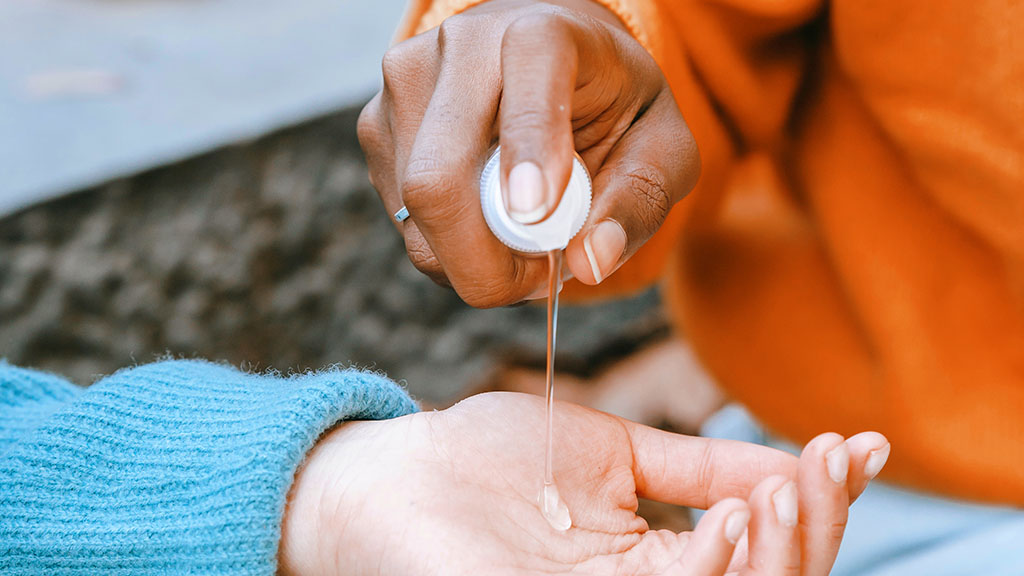As vaccine distribution ramps up across the U.S., event planners and attendees are bringing back in-person events. It’s an exciting time—but events now have a new level of logistics in the event planning process.
Implementing Safety Measures During In-Person Events
Most guidelines show the risk of COVID-19 transmission is highest when people are in close contact and that the disease can spread through infected particles in the air or on surfaces. As an event organizer during the pandemic, it’s your responsibility to prevent that as much as possible.
Facilitate Distancing
At this time, it is believed that COVID-19 spreading often happens when people in an area are less than six feet apart. Physical separation should be one of your most important safety measures when returning to in-person events.
Wherever guests will gather, marking out spacing so people from different households can stay at least six feet apart is a good start. There are plenty of vendors that sell physical distancing signs, floor decals, and other kinds of markers. Use them generously anywhere you might have people waiting in line or occupying a confined space.
Using arrow decals to create one-way traffic in hallways and designate “in” and “out” doors also helps. People are used to following these kinds of signs, and they tend to feel safest with the guidance in place.
Provide Sanitizing Products
Experts believe that the risk of contracting COVID-19 from a touched surface is relatively low, compared to the risk from face-to-face contact. However, it increases when you have large numbers of people touching the same things. To help reduce the risk at your event, you could provide an array of hygienic products such as:
- ‌Disinfecting wipes
- ‌Extra masks
- Hand sanitizer
- Trash cans—to discard wipes and masks
Placing these things at the entrances and exits to your event spaces, and anywhere else there might be high-touch surfaces helps confidence, and may help protect people. Make sure there’s signage directing people to places where they can wash their hands, too. Encourage hand washing in all of your messaging, as this is a commonly recognized guideline and shows you care.
Go Contactless
As anyone who has traveled or made an in-person purchase recently can attest, almost any transaction or interaction can be contactless these days. Here’s an example of how event planners can do it:
- ‌Set up a website where people can register and check in using their phones.
- ‌Make event materials—schedules, maps, etc.—accessible online through QR codes.
- ‌Encourage contactless payment for any on-site purchases, too.
There are many options for contactless payment. Mobile apps like PayPal, Venmo, and Google Pay tend to be easiest in terms of setup, although they exclude non-mobile users and are fine for general transactions. For events, it’s important to find event-specific solutions that synchronize purchases and registrations to make your life much easier.
Prepare for Contact Tracing
If someone tests positive for COVID-19 after your event, you may need to inform everyone with whom that person might have been in contact. One way to do this is to organize people into “pods”—small groups who experience the event together. For events, it’s important to track who shows up, not just who bought tickets, and using the right check-in tools easily does this.
Some regions have Exposure Notification technology available. When people enable this technology on their mobile phones, they receive a notification if they came into contact with someone who has COVID. The technology works via Bluetooth.
Choosing an Excellent Venue
You can maximize your event safety by choosing a venue that might include good airflow, plenty of space for distancing, and flexible layouts. It is also important to note participants will have varying levels of comfort, so make sure people have go-to areas they can feel safe.
Opt to Set up Outside
All other factors being equal, these days, outdoor gatherings are safer than their indoor counterparts. Try to move your event outdoors or at least have some outdoor spaces available.
Look for Large Spaces
Indoors or out, you need to avoid crowding your guests. Look for venue options with large open spaces so people from different households can easily separate themselves.
Manage the Venue Airflow
Airborne transmission is understood as most common in enclosed spaces with poor ventilation. Understanding how air flows in the space where your guests will gather may help create a safer event.
If you need to hold your event indoors, ask about filtration systems and airflow. All rooms should have a one-way flow—air comes into the room from one source and goes out another way. It shouldn’t come back into the same room unless it goes through a high-efficiency filter. There are free-standing air purifiers you can use to improve the filtration if necessary.
Introduce outdoor air wherever you can. If your venue has windows and doors that open, ask if you can use them.
If there are fans available, use them to direct air away from people. Window fans should pull air outdoors and ceiling fans should pull air up. Remember that the ultimate goal is to minimize the flow of air from one person to another.
Keep Everything Clean
People expect shared spaces to be sanitized. Look into the cost of hiring a cleaning crew to fully sanitize your venue before and possibly even during your event. Mid-event cleaning can be important if you have a longer event or many high-touch surfaces.
Communicating With Attendees
The consensus is that controlling COVID requires everyone’s participation. Including COVID-19 awareness and safety practices in your guest messaging can go a long way for comfort and safety.
Send Safety Messages
Even if you’re sure guests have heard the “stop the spread” public services messages, as a community leader it’s important to share that messaging explicitly at your in-person events. The CDC recommends that event organizers:
- ‌Create event signs encouraging COVID safety measures—like handwashing, mask-wearing, and so on—in highly visible locations.
- ‌Broadcast reminders, over a PA system or as part of event announcements, to remind people to follow safety practices.
- ‌Send videos or FAQ sheets about COVID protection as part of your registration system and vendor communications.
You can get free downloadable signs, videos, and more on the CDC Communication Resources page. There are also event specific printing companies that can help like Bibnumbers.com.
Require Proof of Testing or Vaccination
As of April 19, 2021, all U.S. residents aged 16 and over are eligible for the COVID-19 vaccine. This milestone and improvements in testing technology have contributed to live event recovery.
Many event organizers have started to consider requiring vaccinations or proof of negative testing as a condition of admittance. Depending on the type and size of your event, you might ask for documentation upon registration or when guests arrive.
Keep in mind that “fully vaccinated” means that it’s been two weeks since a person’s final dose of the vaccine. The public opinion verdict is still out on this, but consider accepting only the proof that meets this requirement.
Come Out With Waivers and Contracts
Any time people from different households get together, there’s some risk of contracting COVID-19. A liability waiver along with good communication and reasonable planning can help to protect you legally in case someone does get sick and blames it on your event.
Many events and venues have COVID-19 waivers nowadays. You could take a look at Disney World’s standard warning, which states that anyone who enters the park assumes all risk of contracting COVID-19. Disney’s documentation also says that by entering the gates, you confirm that you haven’t had exposure to or symptoms of COVID.
You can also ask guests to sign a safety contract confirming that they will abide by all safety recommendations, including distancing and mask-wearing, while at your event. If you go this route, make sure that you have event staff who are prepared to enforce the rules, as well as registration forms, and or check-in tools that streamline this.
Budgeting for Creating and Organizing Events
COVID safety precautions may make your event more expensive or limit your income by limiting attendance.
Consider Social Distancing
If your guests have to stay six feet apart, you can fit fewer of them into the same size space. Also, many states are still restricting venue capacity and gathering size.
These two factors mean that you may have fewer people attending your in-person events, possibly in a larger space. Make sure your budget can handle it.Â
Understand Safety Costs
Don’t be surprised if your venue charges extra for deep cleaning or safety supplies. Food may cost more as well since you’ll probably have to provide individually packaged meals or snacks, which tend to be more expensive.
Provide Generous Cancellation Policies
A generous cancellation policy makes it easier for people to opt out of attending the event if they’re sick or simply don’t feel comfortable attending. Having one could earn you more registrations. Budget for how many people you think will take advantage of the option.
Also, consider the possibility that you may have to cancel the event altogether. For example, if you have a spike in your state, or if your headliner tests positive. Know what your venue’s cancellation policy is and what it could cost.
COVID’s Virtual Legacy: The Future Is Hybrid
During the pandemic, event organizers and attendees discovered the benefits of virtual events. While nothing can replace a face-to-face experience, the online format can make any event even more successful by welcoming guests from all over the world.
In a recent survey of event planners, 97% said they expect to see more hybrid events going forward. Even if you opt for an in-person event, people may contact you about a virtual option.
Having that virtual option can increase your income stream, attracting people who are too far away or too worried about getting infected to attend your live event. It also shows your consideration for people’s comfort levels, and that goes a long way.
Never hosted a virtual event? You’re not alone. More than three in four survey respondents are in the same boat. Take the time to reach out to colleagues and do some research, finding out how to set up virtual encounters during an in-person event. Possibilities include:
- ‌‌Breakout rooms
- Contests and prizes for online participants
- ‌Integrated live and in-person Q&A
- Live online polling
Your goal is to ultimately make sure everyone feels included, connected, and safe during in-person events. By planning smartly and understanding what needs to be a little bit different this time around, you can organize safer events that people will feel good about attending. Events.com can help you return to in-person events safely.






